ANATOMY OF A RING
JEWELRY, DIAMONDS, RINGS, REPAIRS, JEWELER TERMINOLOGY
This post contains affiliate links. If you use these links to buy something I may earn a commission. Thanks! As an Amazon Associate I also earn from qualifying purchases.
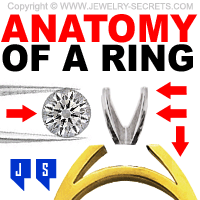
There are a lot of Parts and Components that make up a Ring, Diamond Engagement Ring, or Wedding Band.
Anything from Prongs, Heads, Channel Walls, Beads, Tips, Invisible Settings, Shanks, Sizing Bars, Comfort Fit Bands, Basket Heads, V-Tips, Finish, not to mention the Diamonds themselves…
And the list goes on and on!
So I thought I’d break this lingo down and label and define what everything is with pictures to make it all easy to understand.
With that, I present…
Ring Anatomy 101
I’ll show you a picture with some Jewelry Highlights, and then explain what all this terminology means… in layman’s terms!
Enjoy! :)
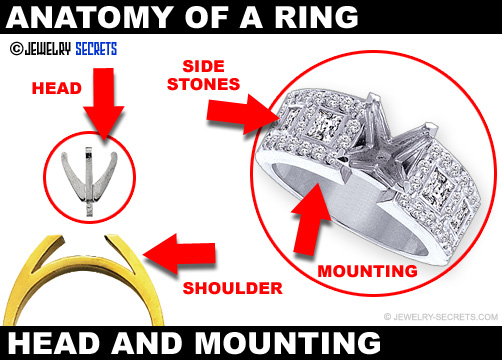
Head
The head is the primary object that holds in the Diamond. Usually it’s 14k White Gold and sits on top of an Engagement Ring or a Wedding Set. The head is made up of the Prongs (how ever many Prongs that may be), along with the base and usually a peg on the bottom to hold it to the mounting.
Mounting
The Mounting is basically the entire ring (normally not including the center stone). It can be Plain, set with Diamonds, or other Gemstones. Sometimes this is also referred to as the Setting.
Shoulder
The Shoulder is usually the top two sides of the ring. It’s the part that Diamonds or Gemstones get set in. You’ll often find Channels or Pave Set Stones here. It generally rises up off the finger and creates the style or design of the mounting. It helps show off the center stone well and also tends to protect it.
Side Stones
Any Diamonds in the ring that are not the center large Diamond are called Side Stones or Accent Stones. The amount of side stones will vary depending on the type of mounting you choose and the amount of Carat Weight you purchase. Side Stones can be Diamonds, or they can be any other Gemstones like Sapphires, Rubies, Emeralds and the such. Usually in an Engagement Ring though, they are Diamonds. :)
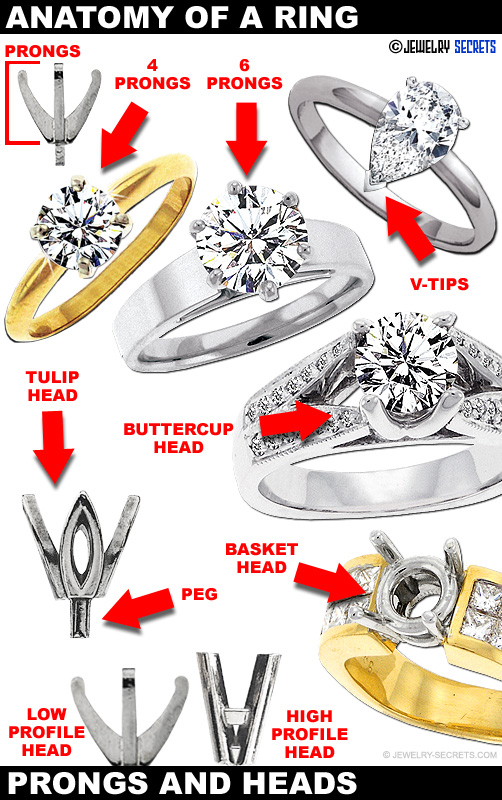
Prongs
Prongs make up most of the Head. They go from the very tips of the points, all the way down to the base. These are the parts of the Head that come up on the sides of the stone, wrap over the top and hold them in so the stones don’t fall out. These are also the parts of the Head that get the most abuse. People hit them, bump them, break them and wear them down often. They will need to be retipped, or have the Prongs rebuilt so they are durable again every 7-10 years or so. When Prongs get too worn down and beyond repair, the Jeweler will recommend putting a new Head on the ring.
4 Prong
A 4 Prong Head is my favorite Head for an Engagement Ring. It shows the Diamond off better than any other head and doesn’t cover up the stone… It shows off as much of the Diamond as possible. I suggest 14k White Gold. White Gold is durable and won’t add any color into the stone.
6 Prong
Many people love 6 Prong heads for a couple of reasons: They offer more protection to the stone. It makes it much harder to hit or Chip the Girdle, and if you break a Prong off, you’ll still have 5 Prongs left so you won’t lose your Diamond. They also tend to give the stone a nice rounded look, where as 4 Prongs sometimes make a Diamond look square. 6 Prongs do cover up a lot more of the stone though, and sometimes even look gaudy. They tend to overpower the stone and may may make the diamond look small.
V-Tipped Head
V-Tips are the perfect Prongs to put on pointed Diamonds, such as the Marquise Cut, Princess Cut, Pear Shaped (as seen above), Trilliant Cut, and any other Cut of Diamond that has an point to it. They not only protect the end and vulnerable tip, but they also give the point a nice pointed look that really enhances the overall shape of the stone.
Tulip Head
Tulip Heads are cute and look like the Petals of a Tulip. They tend to give the ring a little bit more fancy look than just regular Prongs. Some people love them, some not so much. It all depends on the actual styling of the ring. :)
Buttercup Head
Buttercups are pretty much the same as Tulip Heads. Just a fancy style of head that gives the ring a different look and feel. I like Buttercups a lot. I like the smoothness of them and the beautiful curves. They look really great in the right style of mounting and they give a ring a nice elegant appearance.
Basket Head
Basket Heads (the number of Prongs on these will vary) are often used for either very large Diamonds, Diamonds that need to be set down low in the Mounting, or for other Gemstones (Emerald, Ruby, Sapphire, Amethyst…), since Gemstones tend to have a much Deeper Cut than a regular Diamond. P.S. Most Diamond Earrings are set in Basket Heads because they sit closer to the ear. :)
Peg
The Peg is at the base of the Head and is used to plant in a hole in a ring and soldered so it holds the Diamond in place. Some Heads have Pegs, others don’t. It really depends on what the Mounting calls for. Some have a hole for a Peg to go in, others need to be soldered to the setting or sides itself.
Low Profile Head
A Low Profile Head is usually just a Head that sits low in the mounting. This is usually good for people that don’t want their stone to sit up high (so it doesn’t get bumped). You can request a different height of Head when you purchase a ring. The standard is a normal height, or a High Profile Head.
High Profile Head
Most Engagement Rings come with a standard Head of pretty much the same height. This is generally a High Profile Head. It really shows off a Diamond well and makes it the focus of the ring… as it should be.
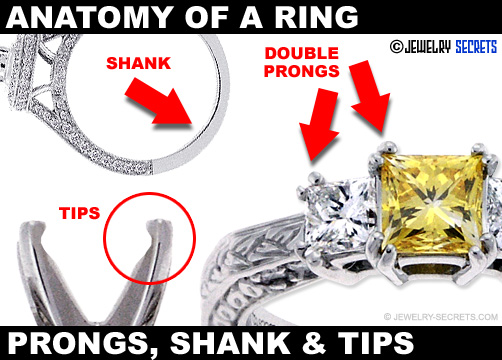
Shank (Band)
The Shank, or as many people just call it, the Band, is the bottom portion of the ring. The part that wraps around your finger on the bottom. This is the area that Jewelers cut when sizing a ring. This is also the area that gets stamped or engraved. It’s also the section of the ring that wears down the fastest since you’re constantly hitting it, rubbing it, bumping it… The Shank tends to get thin, brittle, worn, bent or broken on the bottom. This can be beefed up by Jewelers, but a lot of times it’s not a very cheap process. After all, it does make up half the ring… :)
Tips
Tips are the very top part of the Prongs. Tips are what are bent over the top of the Diamond (The Crown) to secure it in the Head. The Tips will wear down with normal wear and tear over the years. They can get thin, weak, break or even crack off. It’s a good idea to have the Prongs and Tips of your ring checked every couple of months or so. That way, if they need work (such as getting re-tipped), it can be repaired, versus waiting until a Prong breaks off and you lose a stone.
Double Prongs
Every now and then you see a ring with Double Prongs. It’s rare, but it does give the ring a different appearance. I’m on the fence with Double Prongs. I like them, but I also feel like they are double the work and double the cost of repairing them. You have double the chance of getting one caught on clothing and snagging sweaters. I can take them or leave them. It all depends on the ring.
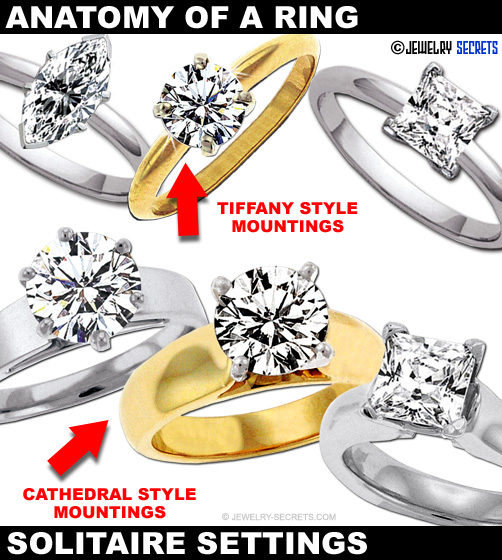
Tiffany Solitaire Setting
Tiffany introduced this Classic Solitaire Mounting many years ago. It’s simple, elegant, dainty, classy, and never goes out of style. It is the ultimate look for a Single Diamond. It sets it up high and shows off the masterpiece. Many Jewelers make different variations of the Tiffany Style Ring. Some have smooth rounded sides, some have a beautiful knife-edge, others have fancy scroll work, swooped sides, or even Comfort Fit Shanks. You can’t go wrong with a Classic Mounting. And it’s the only one I recommend if you don’t know what style of ring or mounting she’d prefer. Get her this simple ring and let her pick out a different mounting later… if she so desires! :)
Cathedral Style Mountings
I adore Cathedral Style Mountings. They are called that because of the way they rise up on the side of the stone, like an arch. There are tons and tons of different Cathedral Mountings. Some are wide, some thin, some are rounded, squared off, some have fancy design work, others have stones running down the sides. No matter what style you choose, you’re certain to love it. It helps protects the Diamond because it comes up on the sides (Some come all the way up to the top of the Diamond). It’s also very durable to wear, and it looks outstanding with larger Carat Weights! It’s an impressive ring with a bold look. I love them! One suggestion I will point out… Don’t get a Cathedral Mounting that’s wider than your Diamond. It will make the Diamond look small and make it disappear in the mounting. :)
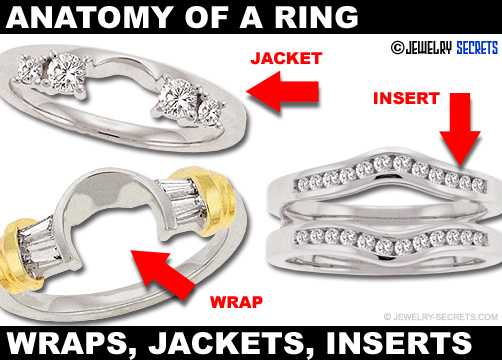
Wraps
A Diamond Wrap is a Wedding Band that wraps around a Solitaire Mounting, like a Tiffany Style Ring. It’s pretty much the same thing as Jackets. Just called different things by different Jewelers. There are endless styles and designs of Wraps out there: Two-Tone, Plain, Channel Set Stones, Prong Set, Gemstones… It really is countless. I like a wrap that doesn’t sit up too high, that way it doesn’t overpower the center stone.
Jackets
Same thing as a Diamond Wrap. It goes up against, or around the Diamond Solitaire. Some Jackets just snug part of the stone, while others wrap almost entirely around the Diamond. And they also make Jackets that go up and over the stone, locking it in place, so you won’t need to get them soldered. They are cool and a great feature for Tiffany Style Bands. Do note that if you have a wider Engagement Ring, Wraps and Jackets may not work! You may have to opt for Custom Designed work where they will make a band to fit the Engagement Ring.
Inserts
An Insert is usually a variation of a Jacket or Wrap, but there is a band that goes on either side of the Solitaire. Usually these two rings are joined together by bars at the base and the Solitaire will slide down in between them (inserted). Inserts can be nice if you get the right one. Often I find most of them gaudy and overpowering to the center stone. I find simple pieces work the best. Ones with small Carat Weights, just enough to add some bling to the ring. :)
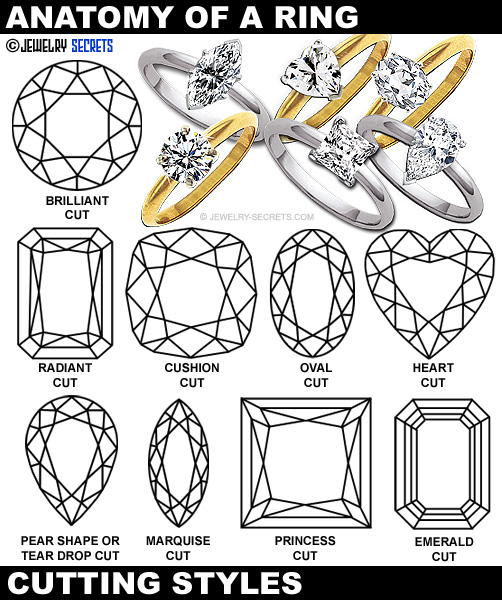
Different Diamond Cutting Styles
Many people think CUT is the shape of the stone, as in Round, Square, Rectangle, Triangle, but it’s not. Not entirely! The shape is the result of the Cutting Style. The Cutting Style is the way that Diamond Cutters facet a stone. The angle of the Facets, the angle of the Crown, the Pavilion, how they all intersect. The proportions and percentages that define the MAKE of the stone.
Popular Cutting Styles are: The Brilliant Cut Diamond (Most Popular Cut), the Princess Cut (Square or Rectangle Cut), the Marquise Cut (Boat Shaped, Diamond Shaped as in Playing Cards, or Football Shaped), Pear Shaped or Tear Drop Shaped, Emerald Cut (Rectangle Cut), Radiant Cut (another Rectangle Cut), Trilliant or Trillion Cut (Triangle Cut), Heart Shaped, Oval Cut and Cushion Cut.
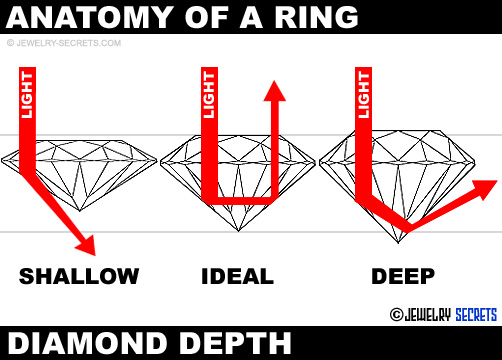
Depth of the Diamond
You’ll hear a lot about the way a Diamond is Cut when you’re shopping for Diamonds. Often though, this talk is limited to the basic diagram you see above. They’ll say that if a Diamond is Cut too Shallow or too Deep, you’ll lose light and life, sparkle and brilliance. And that’s it! While this is all good, and it does all depend on how deep the Diamond is Cut, there is a lot more you should know about the subject. The amount of info on Cut is enough to fill an entire website… Like I do with my website here. :)
For beginners, it’s much easier to just follow GIA’s Cut Grades to determine if your stone is giving you the maximum amount of beauty and sparkle. Opting for a Cut Grade of Excellent or Very Good is what I would shoot for. That way, all she’ll see is a million twinkling, dancing, flashes of light, and you won’t have to analyze every single angle and percentage. :)
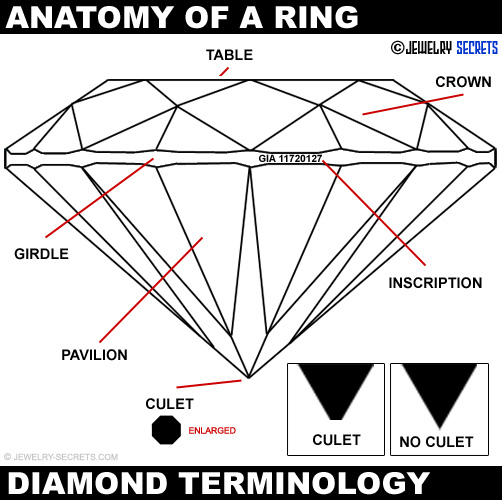
The Diamond itself is made up of lots of different Facets and each part plays a crucial role in how the Diamond interacts with light. Let’s take a look…
Table
The Table is the top flap portion of the Diamond. It’s Octagon Shaped and allows you to see inside the Diamond and view all the Brilliance (White Light) and Fire (Colored Light) that a stone gives off. The Ideal size of the Table varies, but most professionals suggest a Table Percentage of 52.4 – 57.5%. Older Diamond Reports would list these percentages at the top of the Report under CUT, but now you’ll often find these down below with the Diamond Cut Profile, which will also list other Facet Percentages and Angles of the stone as well.
Crown
The Crown is the entire portion of the Diamond above the Girdle. The Ideal Crown Angle is 33.7 – 35.8%. You’ll find this listed on a Diamond Report such as GIA’s Full Diamond Reports (the Best there is). If the Crown is too high, or too shallow, the light will not bounce right in the Diamond, and the Diamond may appear Dark and Lifeless.
Girdle
The Girdle is the line that splits the Diamond into two sections (from a side view): The top section is the Crown, and the bottom section is the Pavilion. The Girdle can be given a number of Grades: Very Thin, Thin, Medium, Slightly Thick, Very Thick, and Extremely Thick. The BEST Girdle to have is either Thin, Medium or Slightly Thick. That way it won’t stand out or look obvious. Girdles should also be even in proportions all the way around the stone. If the Girdle is wavy or uneven (like Thin to Thick), it usually means the rest of the stone is out of proportion as well. The Girdle is the weakest part of the Diamond, and often when people chip or break their stone, it’s because they hit the edge of their Diamond too hard.
Pavilion
The Pavilion is the base of the Diamond below the Girdle. The angle of the Pavilion help bounce light across the stone so it comes back out in a million flashes of light. A stone that’s cut too shallow or too deep will lose light out of the bottom of the Pavilion and leave the Diamond dull. An Ideal Pavilion angle is 40.15 – 41.2%.
Culet
The Culet is the very tip or point at the base of the Diamond. Your Diamond will either have this Octagon Shaped Facet, or it will have no Culet at all and just come to a very sharp point. Either way, unless the Culet is too large, it won’t bother the look or feel of the stone. The big problem lies with a Diamond with NO CULET, as this makes the end of the stone prone to chipping or breaking, especially when Jewelers are setting the stone in a Mounting or Head. You’ll find the size of the Culet listed on a Diamond Report. The Best Culets to get are Small or Medium… That way they are not obvious when looking down into the stone. A Large Culet can look like a bullet hole!
Laser Inscription
An Inscription is done by a Laser and etched directly onto the side of the Diamond Girdle. Often this Inscription is the Diamond Report Number, or Trademark of the stone. This helps to identify the stone and make it easier to match the stone up with the actual report. I highly advise buying a Diamond that’s Laser Inscribed. It protects you and prevents Diamond Switching!
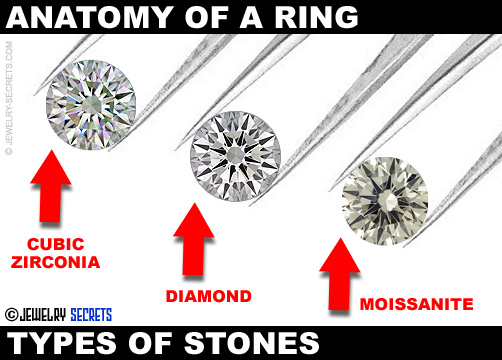
Diamond
Most Engagement Rings are set with Diamonds of various qualities. A Good Clarity stone is generally in the SI range, and a good Color is often in the G-H range. I tend to lean more towards better quality stones of VS Clarity and E-F Color though, just because it adds much more beauty, sparkle, brightness and whiteness to the stone… Also dependent on having a Great Cut (Excellent or Very Good) as well!
Cubic Zirconia (CZ)
Let’s face it, there are a lot of Diamond stimulants out there. The most popular stone is the Cubic Zirconia (or CZ). This stone mimics the look and feel of a real Diamond, but CZ’s don’t last as long. They are more brittle, chip easier, and will dull down with scratches and the facets rounding off. CZ’s also appear slightly different from Diamonds in the way they grab light. They tend to have more sparkles of COLOR in the stone. A dead give-a-way! CZ’s are a cheap substitute, but not recommended for an Engagement Ring where the stone will only last so long… Unless that’s what you want! :)
Moissanite
Moissanite is a Diamond Look-A-Like that’s hit the market in the last 10 years or so. The stone tests positive on Diamond Testers (unless you have a newer tester that also tests for Moissanite), but the stone does tend to have more Color in the stone than a normal Diamond on the market. The stones appear more yellow in hue. Moissanites are becoming more popular because they are as durable as a genuine Diamond, but only cost half as much. It just depends on whether you care for the yellow shade, and don’t mind not having a real Diamond in your ring. This could be the way to go?
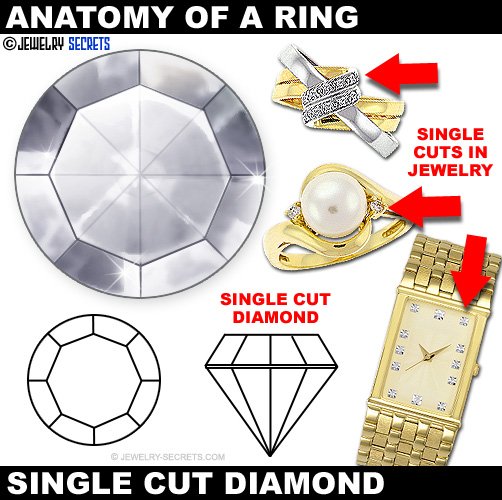
Single Cut Diamonds
Single Cut Diamonds (also called 8/8 Diamonds, or Melee), have 16 Facets (8 on the top Table, and 8 on the bottom Pavilion) in all (17 Facets if there is also a Culet). They are small stones, often under 10 Points (.10 CT) or so, and tend to give off minimal sparkle. They are usually used to enhance rings or Jewelry, such as side stones, Accent Stones, or stones in Watches. They don’t need to have any more Facets than they do, because they are so small, it wouldn’t make much difference anyway. Single Cut Stones help keep the cost of the merchandise down, and still giving that pizzazz that Jewelry needs. :)
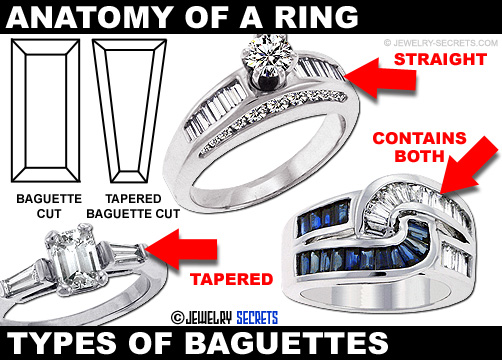
There are two different types of Baguette Cut Diamonds: Straight and Tapered…
Straight Baguettes
Straight Baguettes (Baguette means “Little Stick” in French) have parallel sides and look like a small rectangle. They have very few Facets on them and mainly just reflect light to add some sparkle to the ring. They look great because they are flat, elegant and beautiful in a Channel Set Ring. I love Baguettes, but they do tend to dull up quickly because they get dirty on the bottom of the stone. They need to be cleaned often so they obtain their brilliance and sparkle and don’t look dark.
Tapered Baguettes
Tapered Baguettes are used to give the ring a different look. They can enhance a Solitaire like shown above by bringing focus to the center stone, or they can work great in curved channels. They use Tapered Baguettes because they can be placed side by side around a curve to achieve a smooth flawless look. The only problem with Straight or Tapered Baguettes, other than the fact that they get dirty quickly, is the fact that they are thin and if hit too hard, they can break easily or crack in half. You have to be careful with them. The best way to protect them is by setting them in channels where the walls of the ring will keep you from hitting their vulnerable edges.
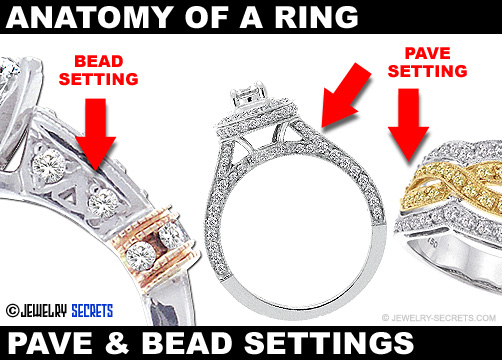
Pave Set
Pave Set Rings are some of the most beautiful rings on the market. I am in LOVE with Pave Set stones. They look Spectacular! Brilliant! Simply Stunning! Small Diamonds are set side by side in the ring and held in place with tiny prongs or small beads to create a seamless sea of Diamonds. They are awesome! I highly recommend them. You can get a tremendous look for a great price because they use smaller Carat Weights, but a lot of them. Check them out! You’ll love them too.
Bead Set
Bead Settings are similar to the way they set Pave Set Stones, but in Bead Settings they aren’t usually placed side by side. Often they will be spaced around the ring and incorporated with the actual design and style of the mounting. Little beads or prongs hold the Diamonds in place.
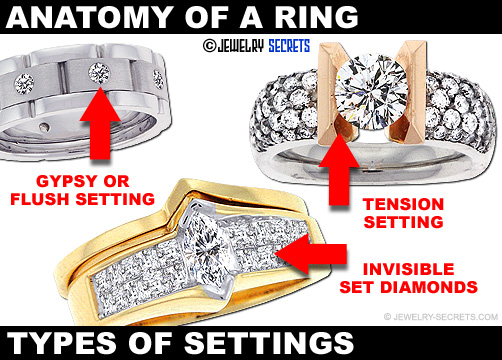
Flush Set
Flush Set, or also known as Gypsy Set, is where the Diamonds or stones are set flat or flush with the mounting. Generally small holes or groves are drilled down into the band and the Diamonds are snapped into place. They give the ring a smooth and graceful look with no prongs or nothing to get snagged. I truly love Flush Settings and love their elegant appearance.
Tension Set
Tension Settings are where there is no head or prongs to hold in the stone. The stone is held in place by the actual mounting and nothing else. The Jeweler cuts small grooves in the wall of the ring and the edge of the Diamond fits into these slots and the mounting is pressed together until the Diamond is held safe and secure. I like how they look, but Diamonds Tension Set often come loose when bumped or hit. It could even damage or crack the stone since the sides are open. So while they look cool suspended in the mounting, they aren’t the best way to protect your valuable stone.
Invisible Set Diamonds
Invisible Set Diamonds are where the Diamonds are set into a wire frame-work below the stones. They actually snap into place like pieces in a puzzle. I like how they look, but stones that are Invisible Set often get knocked loose and when this happens, many times all the stones will come loose and fall out. Not cool! I would pass on both Tension Set stones and Invisible Set stones… Just to be safe!
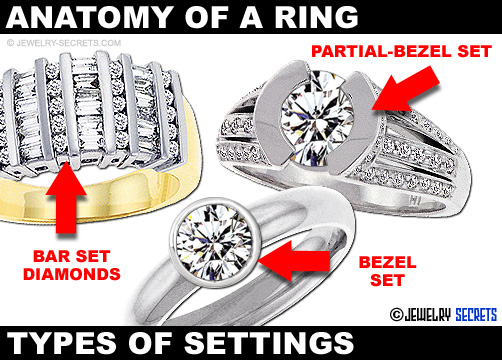
Bezel Set
Bezel Settings are where a rim of metal is wrapped around the top edge of the Diamond holding it in place. Often this Bezel is like a cup that the Diamond sits into and then the rim is bent over the top of the stone and polished off to make it look smooth and elegant. Bezel Settings are beautiful and you won’t ever have to worry about prongs catching on things. The Downside: Bezels do make the stone appear smaller since the entire outer edge is covered up. But if you want a clean, smooth ring, you can’t go wrong with this particular style.
Partial Bezel Set
Partial Bezels are where only half, like the top and bottom of the stone, is covered up by a rim of metal. The stone is partially in a bezel. I like Partial Bezels because they show off more of the stone (The Stone still looks big) and they still greatly protect it. :)
Bar Set
Bar Set stones are similar to Channel Set stones with a bar on either side of the stone, but they aren’t closed up or boxed in. The bars are usually open at the ends. You’ll find may different types of Bar Settings, but they all tend to look good and work well at protecting the stones.
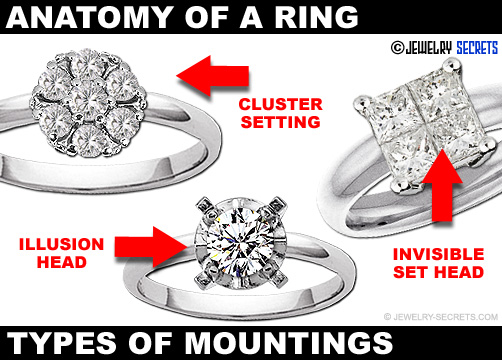
Illusion Heads
Illusion Heads give the illusion that the Diamond is bigger than it really is. The Illusion is where the Diamond is placed in a bigger flat plate that is often Diamond Cut to add more sparkle and brilliance… Making it look like it’s part of the stone. Hence, a bigger Diamond appearance. :) Illusion Heads used to be real popular in the olden days, but now new varieties are seen instead. Like the Invisible Set Illusion Heads…
Invisible Set Heads
Rings like this are all the trend right now. Usually 4, 6 or 8 Diamonds are set in a wire-frame head and gives the look of one huge stone, but aren’t. They may mimic a One Carat Diamond, but the Carat Weight could be only .33 CT instead. So you get the look, but only pay a portion of the price. You do have to be cautious with Invisible Set stones… they can come loose and fall out of the mounting easier than other types of settings. Be careful!
Cluster Heads
Cluster Heads are where a bunch of Diamonds are set in a plate or design to look like a lot of stones and a lot of Carat Weight. It’s a good way to achieve a grand look and not pay a grand price. :)
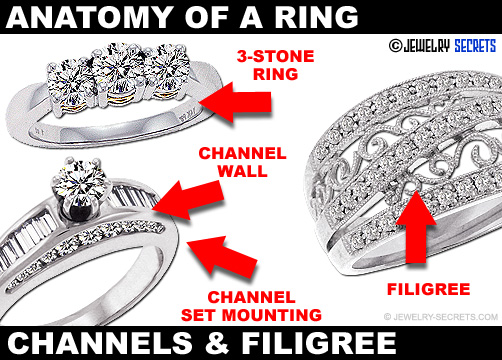
3 Stone Rings
3 Stone Rings are pretty popular. 3 Diamonds are set in a mounting side by side in a row. Usually the center stone is bigger than the two side stones. You’ll find these come in different Carat Weights like .50 CTW, .75 CTW and 1.00 Carat Total Weight. A lot of people will wear these as Engagement Rings, but often you’ll see people buying these as Anniversary Bands as well. They make great rings no matter which way you wear them. :)
Channel Settings
Channel Settings are one of the most common types of mountings today. You see Channel Set Diamonds (Set in the walls of a Channel) in just about every style and design in stores and showcases. They give the ring a nice clean, smooth look and you won’t have to worry about prongs, retipping, snagging or anything of the sort. Elegant and effective, I love them! :)
Filigree Mountings
Filigree is most often found on Wedding Bands, but sometimes you’ll see their intricate designs in Wedding Sets and Engagement Rings. They look awesome with their beautiful twists and curves. They remind me of the Renaissance Era with the fancy web-work and frills. Just be careful with these beautiful styles, the fine, dainty lacework may not be so durable or withstand the abuse that we put our rings through.
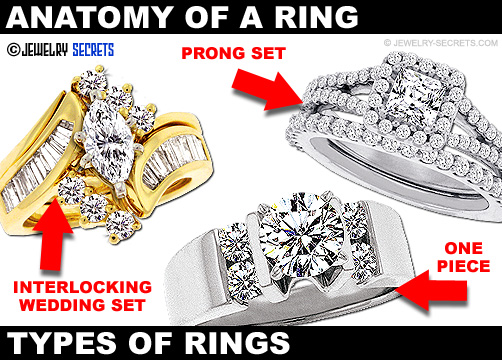
Interlocking Wedding Sets
This is a very cool way of linking rings together. Many Sets are interlocking sets and either hook underneath the other ring or latch together with a simple hook and slot. I think they are cool and look great. The Engagement Ring works good by itself, but then when you add in the Wedding Band, it just completes the look. And you won’t need to solder them together either. You can separate them at any time, if needed. :)
Prong Set Rings
Many times an Engagement Ring or Wedding Set that is made up of mostly prongs, is called a Prong Set Mounting. They have a lot of prongs and they hold a lot of Diamonds (Think Ladies Cocktail Rings). The only problem with too many Prongs… the cost of repairs when they wear down, get thin, bend or break. It could run a pretty penny the more prongs you have. I usually advise Channels Sets instead!
One Piece Rings
One Piece Rings are all the rage. They are ultimately the Engagement Ring and Wedding Ring made together as one. Just one ring for everything! (One Ring to rule them all) You get the entire look now, and don’t have to wait for the Wedding. :) It’s for the person who likes a simple, classy style, and doesn’t want to worry about the fuss fuss.
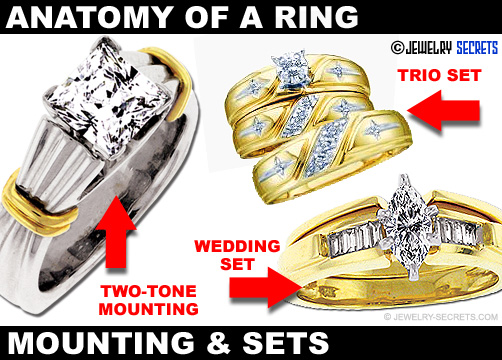
Two Tone Pieces
Two-Tone Rings are rings that are made of two different types of metals. Usually this is Yellow Gold and White Gold, but you’ll find rings of Platinum and Gold, or Gold and Titanium on the market as well. I like the look of two-tone because you can wear them with anything and everything. They go good with all your other White Jewelry and your Yellow Jewelry as well! It’s the perfect match for a perfect fashion.
Trio Sets
Trio Sets used to be very popular in the 80’s. Now, not so much! Trio Sets are a set of 3 rings: The Ladies Engagement Ring, Ladies Wedding Ring and the Men’s Wedding Band. And the interesting part: THEY ALL MATCH! Matching bands used to be the thing to do. But these styles are generally cheap, thin and carry low quality Diamonds. They do make better versions of these Trio Sets, but to me, they still all look like cookie-cutter rings and I wouldn’t advise them.
Wedding Sets
The term Wedding Set basically means two rings sold together as one set: The Ladies Engagement Ring and the Ladies Wedding Ring. They were made to go together and when worn as one, often complete a style or design. Sometimes the Wedding Ring may be nothing more than a simple, plain band that fits flush up against the Engagement Ring. But sometimes you’ll find the Wedding Ring as complex and full of Diamonds as the Engagement Ring is. It all depends on the look and feel you desire.
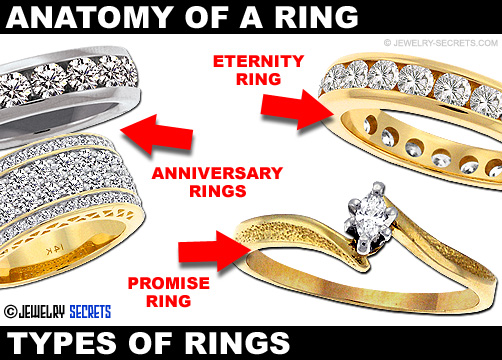
Promise Rings
Promise Rings are small rings, often with small Diamonds, that are given to your partner as a promise of your loyalty and commitment. I promise that someday we will walk the isle and say “I DO”. It’s a token of love and comes from your heart. You’re mine and I want the world to know that… if only for a little time! :)
Anniversary Rings
Anniversary Rings are rings given to your Wife for an Anniversary. Whether it be one year, two, ten or one hundred, the year you decide to give her one, or the size of the Carat Weight you give doesn’t matter much. It’s just a wonderful opportunity to give her Diamonds, a show of your endless love throughout the years! There are thousands and thousands of Anniversary Bands in Jewelry Stores today. Just pick something you like and something you feel comfortable with. Sometimes these bands are meant to be worn up against the Wedding Set on the same finger, but often, because of the rings themselves, they will be worn on the opposite hand instead. Which finger you wear it on is no big deal. The deal is the celebration of another year together! Congrats!
Eternity Rings
Eternity rings are where the Diamonds go all the way around the entire ring. The entire shank has Diamonds, they go around the bottom of the ring and connect to the other Diamonds on the other side to form one big line of endless stones (an Eternity). The two problems these types of rings create: They are almost impossible to size (no place to size them at), and with stones on the bottom of the ring, you’ll be hitting and bumping them often, which could result in broken or loose Diamonds. Care should be taken with Eternity Rings, or you’ll spend an eternity fixing them!
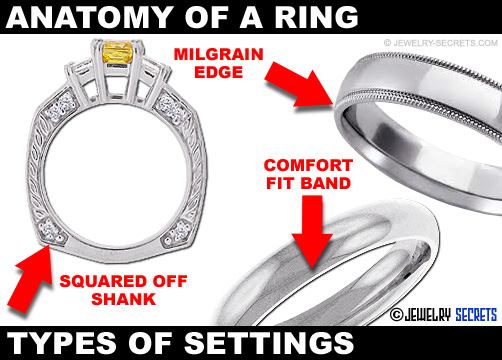
Comfort Fit
Comfort Fit Bands are rings that are heavier and rounded at the shank so they fit more comfortably on the finger. They are durable and thick and you won’t ever have to worry about bending them or breaking them (Mechanics love them). People that are physical with their hands or do a lot of activity will adore comfort fit bands. The only downside to them: They are thicker between the fingers as well, so if someone grabs your hand really tight to shake it, the ring will smash into your fingers and bones and it tends to hurt quite a bit.
Squared-Off Shank
Rings that have a flat bottom, or squared off shanks (or square-rounded off as seen above) are made for 2 reasons. 1) Design. They look cool, different, artsy and stylish! 2) They help keep your ring from spinning around on the finger because the flatter sides keep them upright on the sides. Pretty neat, eh?
Milgrain Edging
Milgrain is just a design in the ring, like small bumps, bead work, or edging around the mounting (see images above and below). You’ll see this style a lot in Wedding Bands. It’s just a neat look that adds personality to the ring without having to add much else.
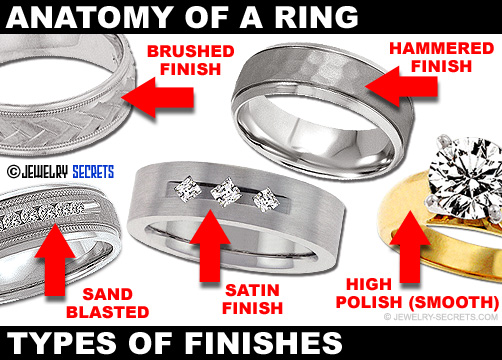
Different Types of Finishes
There are plenty of ways to finish off a ring. The most popular style is a High Polish, where the metal glistens in the light, sort of like a mirror. But you’ll also see a lot of different designs, especially in Men’s Rings like: Hammered, Brushed, Sand Blasted, Diamond Cut, Satin Finish, and more. Jewelers use tools like wire brushes and carving tools to create fun designs and patterns in the Gold (or whatever Metal it is). Not only does it help give the ring a cool look, but it also helps hide scratches and dings better. That’s why you’ll find them a lot in Men’s Wedding Rings. Men are rough on their Jewelry. Different Finishes tend to fix that. :)
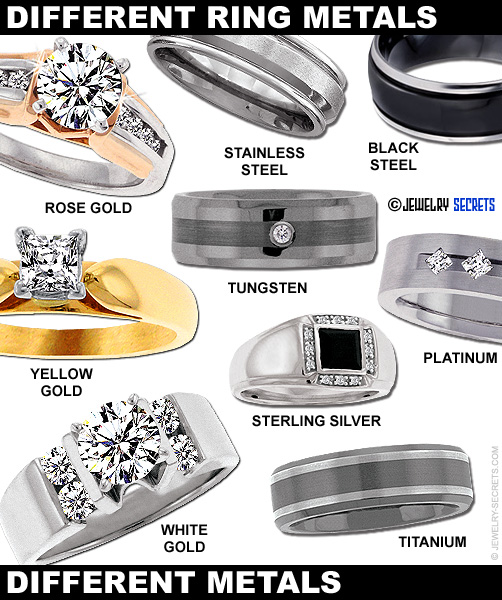
Different Types of Metals
There are plenty of choices of Metals on the market today: Silver, Gold (White Gold, Yellow Gold – 10k, 14k, 18k are the most popular Karats), Platinum, Stainless Steel (Black Steel as well), Tungsten, Titanium, and different Colors of Gold like: Rose Gold, Green Gold, Blue Gold, Black Gold, and Purple Gold… Colors you can’t even imagine. The most popular Metals for Engagement Rings are White Gold, Yellow Gold, and Platinum. The other types of Metals like Tungsten, Titanium, and Stainless Steel are found a lot in Men’s Bands since they are very durable and Guys like the more gun-metal gray look. :)
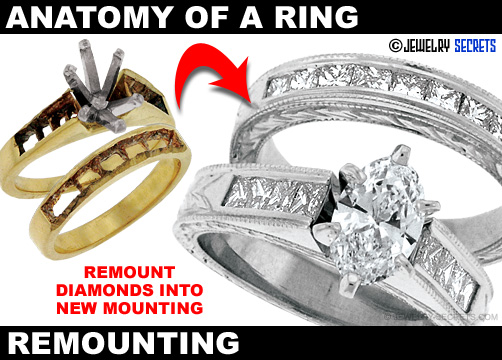
Remounts
Remounts are where you take the Diamonds out of your old rings and mount them into a brand new setting. It’s a great way to get rid of your old Yellow Gold ring that you no longer like and putting them into a fresh, new, trendy White Gold Ring. Plus, it’s FUN! Jewelers do this all the time, or you can wait until one has a Remount Show where they set your stones into the new setting while you watch and wait! That’s a neat thing to experience. Why not? If you have any Diamonds in any rings you don’t wear, sell them, trade them, or remount them. You might as well put them to good use. :)
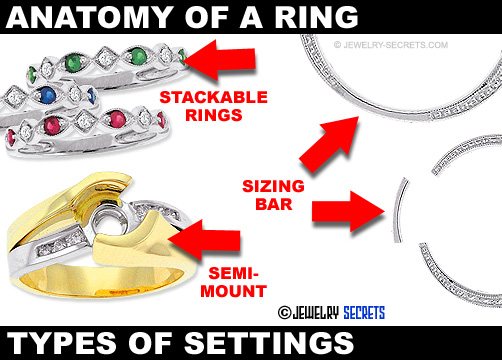
Semi-Mounts
A Semi-Mount is what Jewelers call a ring that has side stones (usually Diamonds) but no center stone. It’s just the mounting missing the main Diamond. These are for people who want to buy their center Diamond Loose first (like a Certified Diamond), and then pick a mounting they love and have them put together as one. I actually recommend doing it this way. That way you can see exactly what stone you’re getting for the main showpiece (and microscope every inch of it), and then set it in a ring that gives you a one of a kind appearance. It’s good stuff and there are tons and tons of different styles and designs out there. You can’t go wrong with creating your own look!
Stackables
Stackables are more often used more for casual or fun rings, but you can find some cool Anniversary Bands that are stackable as well (like the ones shown above). They are called Stackables because you can stack them one on top of another (as many as you like). They will usually have different Colored Gemstones in them, or different shades of Gold. It really can be quite cool. You can put so many rings on your finger that it won’t even bend. HA! I’ve actually seen this happen!
Sizing Bar
The Sizing Bar is where the design of the ring doesn’t continue all the way around the ring. It has a small section on the very bottom that’s primarily used for sizing purposes. Otherwise, Jewelers would have to cut the actual pattern and try to blend it together at the bottom when they’re done. It gets difficult to do this and many times it just doesn’t look right. The Sizing Bar makes sizing rings simple and painless.
If you have more items you’d like to see added to this list, drop me a line and I will post them.
Thanks much!
I hope this helped! :)


















I have some Rings with bezel set colored stones. Unfortunately the stones have cracked and I would like to replace them. How difficult is it to replace stones in a bezel set ring?
Hi James, any professional jeweler should be able to fix it. They will have to pry up the bezel lip, insert another gem of the same size, then push the lip back down and smooth it out. It may not ever look perfect again, but chances are, no one will notice. That’s the only way to fix it, other than replacing the bezel as well. -Richard
I have an engagement ring that has a small square chunk of metal that is missing from the band, near the bottom, close to where they would cut in order to resize it. It doesn’t go all the way through the band and there are no stones near it. Any idea why this square void would ne there?
Hi Chris. Maybe there was a plate with a logo or stone that was originally placed in the hole. Maybe a spot for a stamp? Without seeing it, I really couldn’t tell. But it sounds like a design, versus any kind of flaw or repair. -Richard